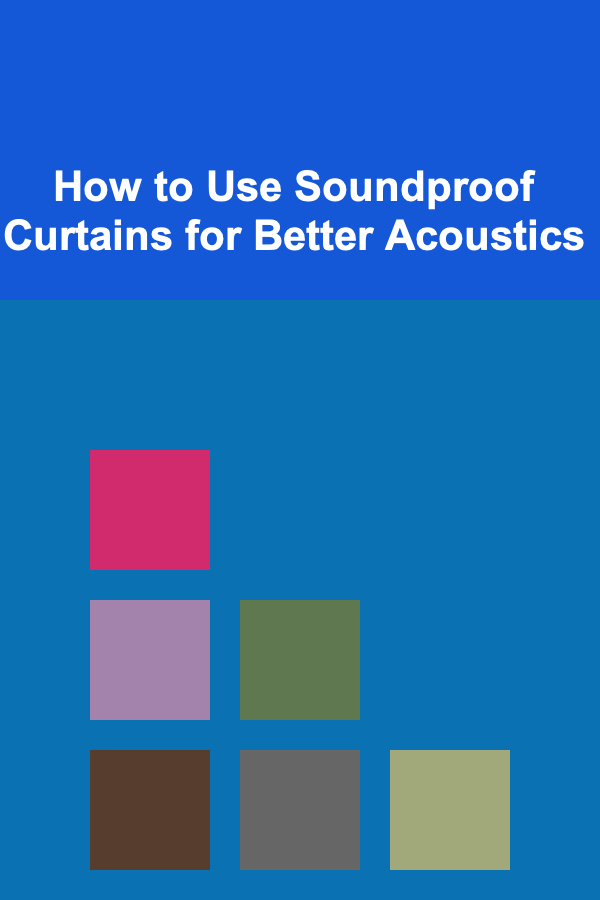
How to Effectively Use Negative Space in Your Designs
ebook include PDF & Audio bundle (Micro Guide)
$12.99$6.99
Limited Time Offer! Order within the next:
Not available at this time

Negative space, also known as white space, is a crucial element in design that often goes unnoticed yet plays an essential role in creating visually appealing and functional compositions. Whether you are working on graphic design, web design, or any other form of visual art, the thoughtful use of negative space can elevate your work, guide the viewer's attention, and improve overall readability. In this article, we will delve into the concept of negative space, explore its importance, and provide practical tips on how to use it effectively in your designs.
Understanding Negative Space
Negative space refers to the area around and between the subjects of an image or composition. While positive space represents the elements (such as text, images, or shapes), negative space is the empty space that surrounds and defines these elements. In simpler terms, it's the "breathing room" in a design that helps prevent visual clutter.
At first glance, negative space may seem like wasted space, but in reality, it serves several important functions. It creates balance, emphasizes key elements, guides the viewer's eye, and can even convey meaning. Negative space isn't just the absence of content; it is an active part of the design that contributes to its overall effectiveness.
Examples of Negative Space
Some famous logos and artwork make excellent use of negative space to enhance their visual impact. For example:
- FedEx logo: The space between the "E" and "X" forms an arrow, symbolizing speed and precision.
- World Wildlife Fund (WWF) logo: The negative space within the shape of the panda creates a powerful visual and reinforces the organization's focus on wildlife conservation.
In both cases, negative space is not simply a design afterthought; it is a deliberate and strategic choice that adds depth and meaning to the logo.
The Importance of Negative Space in Design
Negative space is far more than just an aesthetic choice; it significantly influences the functionality and usability of a design. Here's why it matters:
1. Improves Readability
In design, especially for printed materials or digital interfaces, readability is paramount. By incorporating sufficient negative space, you allow the eyes to rest and easily distinguish different elements of the design. Text that is tightly spaced together with little or no surrounding white space can feel overwhelming and difficult to read. When used effectively, negative space around text or images can provide a sense of clarity, making it easier for the viewer to absorb information.
2. Creates Balance
Visual balance is a fundamental principle in design. Negative space helps achieve equilibrium by distributing elements in a way that doesn't overload one side of the composition. A design that lacks adequate negative space may feel crowded or chaotic, while a well-balanced design with negative space offers a harmonious and aesthetically pleasing experience.
3. Guides the Viewer's Eye
The strategic use of negative space can guide the viewer's eye through the design in a deliberate and intentional way. It allows the designer to control the flow of attention, leading the viewer's eye from one focal point to another. For example, a clean and open design with generous negative space around key elements will naturally draw attention to those elements, such as a call-to-action button or an important piece of text.
4. Enhances the Message
Negative space is also a powerful tool for conveying meaning. A thoughtful arrangement of negative space can convey messages and ideas that the viewer might not initially notice. For example, a clever use of negative space can reveal hidden symbols or shapes that reinforce the theme or message of the design, creating a deeper, more meaningful connection with the viewer.
5. Establishes a Visual Hierarchy
In design, it's crucial to establish a visual hierarchy that helps guide the viewer's eye in order of importance. Negative space can play a critical role in this process. By surrounding primary elements with more negative space, you can emphasize their importance. Conversely, secondary or less important elements can be placed with less negative space to deemphasize them.
Types of Negative Space
There are two main types of negative space that designers can use:
1. Active Negative Space
Active negative space is when the empty areas within a design are intentionally used to create shapes or patterns that contribute to the overall composition. For example, in a logo design, the empty space between two shapes may form a recognizable symbol or icon, contributing to the brand's message. Active negative space is often used to create clever or hidden imagery that can surprise or delight the viewer.
2. Passive Negative Space
Passive negative space, on the other hand, refers to the more traditional approach to white space, where the empty space exists simply to provide balance and breathing room between elements. While passive negative space doesn't always create hidden shapes or symbols, it still plays a critical role in making the design more readable and visually appealing.
How to Effectively Use Negative Space in Your Designs
To make the most of negative space, designers should adopt certain techniques and practices. Here are some key strategies for using negative space effectively:
1. Don't Be Afraid of Empty Space
Many designers tend to fill every inch of the canvas with content, fearing that empty space might make the design feel incomplete or unfinished. However, embracing empty space can be liberating. Negative space provides the necessary room for the design to breathe and allows the viewer's eye to focus on the key elements.
Incorporating empty space intentionally is one of the easiest ways to elevate your design. A minimalist approach, where you let the space around the subject speak for itself, often results in a clean, sophisticated, and high-impact design.
2. Use Negative Space to Create Focus
One of the primary benefits of negative space is its ability to create focus. By surrounding important elements with negative space, you guide the viewer's attention to those elements. For example, if you are designing a website with a call-to-action button, placing it in a large area of white space can draw the viewer's eye toward it, making it more likely that they will engage with the content.
3. Experiment with Shape and Form
Negative space can be used creatively to form shapes or icons that reinforce the design's message. One technique is to incorporate shapes within the negative space that align with the theme or purpose of the design. For instance, a design for a tech company might use negative space to create a subtle representation of a circuit board or a digital pattern.
4. Create Visual Contrast
Negative space is a great way to create contrast in your design. By juxtaposing densely packed areas with wide open spaces, you create a dynamic composition that feels more alive. Contrast in size, color, and placement can heighten the impact of the design and guide the viewer's attention to the most important elements.
5. Ensure Consistency
While negative space is an important tool for creating emphasis and balance, it is essential to use it consistently throughout the design. Inconsistent use of negative space can make a design feel disjointed and visually chaotic. It's important to find a balance where negative space supports the overall composition and enhances the design's message without being distracting.
6. Maintain a Hierarchy
Incorporating negative space helps establish a clear visual hierarchy in your design. The more negative space you give to an element, the more important it seems. Ensure that the most important information or elements stand out by surrounding them with plenty of open space, while secondary elements can be placed in more compact areas.
Common Mistakes to Avoid
While negative space is a powerful design tool, it's easy to make mistakes that can undermine its effectiveness. Here are some common pitfalls to avoid:
1. Overcrowding the Design
One of the most common mistakes is overcrowding the design with too many elements. In an attempt to communicate everything at once, designers often fill the space with excessive text, images, and patterns. This leads to a cluttered design that lacks breathing room. Always remember that less is often more, and space should be used strategically, not just to fill gaps.
2. Ignoring the Role of Negative Space
Another mistake is to neglect the role of negative space altogether. Simply adding a lot of space around elements doesn't automatically result in a great design. Negative space should be treated as an active element that contributes to the design's meaning and function, not just as a filler.
3. Failing to Use Negative Space to Create Contrast
When negative space is used without considering contrast, the design can appear flat and uninteresting. Contrast between the content and the negative space is essential for a design that grabs attention and keeps the viewer engaged.
4. Inconsistent Use of Negative Space
Inconsistent use of negative space can create visual confusion. For example, if one section of a design has too much negative space while another feels cramped, it can create a disjointed and uncomfortable viewing experience. It's important to create a sense of harmony by using negative space consistently across the design.
Conclusion
Negative space is one of the most powerful, yet often overlooked, tools in a designer's arsenal. When used effectively, it enhances the overall composition, improves readability, guides the viewer's attention, and adds meaning to the design. Whether you are designing a logo, a website, or an advertisement, understanding and mastering the art of negative space is essential for creating visually impactful and memorable designs.
By embracing the beauty of empty space, you can create designs that are not only aesthetically pleasing but also functional and engaging. Remember, negative space is not a void---it is a vital part of the design process that, when used thoughtfully, can transform a good design into a great one.

Beyond Sales: Building Long-Term Relationships Through Customer Success Management
Read More
How to Create a Family Communication Plan with Your Kit
Read More
How to Integrate Virtual Assistants with Your Dropshipping Automation Tools
Read More
How to Organize a Last-Minute Home Party Without Stress
Read More
How to Use Soundproof Curtains for Better Acoustics
Read More
How To Master Your Eyebrow Shape and Fill
Read MoreOther Products

Beyond Sales: Building Long-Term Relationships Through Customer Success Management
Read More
How to Create a Family Communication Plan with Your Kit
Read More
How to Integrate Virtual Assistants with Your Dropshipping Automation Tools
Read More
How to Organize a Last-Minute Home Party Without Stress
Read More
How to Use Soundproof Curtains for Better Acoustics
Read More